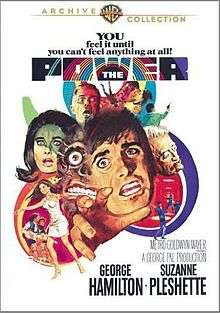The Power (film)
| The Power | |
|---|---|
 | |
| Directed by | Byron Haskin |
| Produced by | George Pal |
| Written by | John Gay |
| Based on |
The Power by Frank M. Robinson |
| Starring |
George Hamilton Suzanne Pleshette |
| Music by | Miklós Rózsa |
| Cinematography | Ellsworth Fredericks |
| Edited by | Thomas J. McCarthy |
| Distributed by | Metro-Goldwyn-Mayer |
Release dates |
|
Running time | 108 minutes |
| Language | English |
The Power is a 1968 film[1] based on the science fiction novel The Power by Frank M. Robinson. The final film to be directed by Byron Haskin, it stars George Hamilton and Suzanne Pleshette. The film concerns a pair of men with the ability to slay somebody with their minds.[2]
Plot
Professor Jim Tanner, a biochemist, discovers evidence of a person with psychic abilities among his co-workers in a research laboratory. His colleagues include geneticist Margery Lansing, physicist Carl Melkinen, biologist Talbot Scott and chairman Norman Van Zandt, all working for Navy liaison Arthur Nordlund.
After a warning from Professor Henry Hallson that one among them possesses a super-intelligence capable of destruction and mind control, Hallson is found murdered with the name "Adam Hart" scrawled nearby. The police make routine checks of the backgrounds of the members of the committee of which Hallson was a member, and Tanner immediately becomes the prime suspect in his murder when it is found that he has apparently lied about his distinguished academic credentials. In fact, all records documenting his past have been erased by some inexplicable method. Hallson's widow Sally Hallson says that Adam Hart is the name of a childhood friend. Tanner visits Hallson's hometown and learns that Adam Hart is a superhuman, with different people providing different descriptions of his appearance, and others still obeying commands that Hart gave them years earlier.
As Tanner tries to uncover the superhuman, his associates are methodically murdered. Talbot Scott, panicked by what is happening, is eventually shot in a confrontation with the police. In a final showdown, Tanner confronts the apparently undefeatable Adam Hart, who is revealed to be Arthur Nordlund. Hart's psychic assault awakens Tanner's own latent psychic powers, and Tanner kills Hart instead. Tanner realizes that he was the superhuman uncovered by Hallson's tests, and that Hart was trying to eliminate any competition from others like himself.
Cast
- George Hamilton – Professor Jim Tanner
- Suzanne Pleshette – Professor Margery Lansing
- Michael Rennie – Arthur Nordlund (alias "Adam Hart")
- Arthur O'Connell – Professor Henry Hallson
- Earl Holliman – Professor Talbot Scott
- Nehemiah Persoff – Professor Carl Melnicker
- Richard Carlson – Professor Norman E. Van Zandt
- Gary Merrill – Policeman Mark Corlane
- Yvonne De Carlo – Mrs. Sally Hallson
- Barbara Nichols – Flora (Joshua Falls diner)
- Aldo Ray – Bruce (Joshua Falls mechanic)
- Celia Lovsky – Mrs. Hallson (Henry's mother)
- Vaughn Taylor – Mr. Hallson (Henry's father)
- Ken Murray – Fred Grover (man at party)
- Miss Beverly Hills – Sylvia (woman at party)
- Miiko Taka – Mrs. Van Zandt
- Lawrence Montaigne – Briggs
- Forrest J Ackerman – Hotel clerk (uncredited)
- Timothy Smith – Elevator Man #1 (uncredited)
- Paul Lyttle – Elevator Man #2 (uncredited)
Production
Produced by George Pal and directed by Byron Haskin, the source novel was substantially changed in the John Gay screenplay, moving the location to San Marino, California, changing most of the characters' names (although retaining the surnames of Tanner, Nordlund, and department head Professor Van Zandt), and eliminating several subplots and characters, presumably to fit the story into a 108-minute film.
Hamilton starred as Professor Jim Tanner, with Pleshette as his teammate and romantic interest Margery Lansing (Marge Hanson in the novel) and Michael Rennie (famous among science-fiction movie fans as Klaatu in The Day the Earth Stood Still) as new government liaison Mr. Nordlund. Otherwise, the story proceeds in a fashion similar to the novel, except for a somewhat different twist to the conclusion. In the movie, Tanner defeats Hart but retains his humanity; in the novel, Tanner sheds his humanity after killing Hart, and looks forward to "playing God" with normal humans, just as Hart did.
This somewhat obscure movie is memorable for a number of intriguing scenes, including murder by centrifuge, a seemingly possessed "Walk / Don't Walk" sign, toy soldiers firing with real gunpowder, and winking inanimate objects (the last two also in the novel). The soundtrack also memorably features a beating heart to signal the mind-control attempts and eerie music from a cymbalum (a hammered dulcimer-like instrument) accompanying the more suspenseful moments.
The music, written by Oscar-winning composer Miklós Rózsa, contributes an amusing fourth wall-breaking moment when Tanner, hearing the haunting tune, seems to expect a new disaster, only to be visibly relieved when he finds a cymbalum-violin duet being performed in the hotel lobby. This was Rózsa's final score for a film produced by MGM, for which he had scored numerous films throughout his career.
Legacy
There is a scene of what may be the first appearance and operation by telekinesis of a psi wheel in a movie.[3]
See also
References
- ↑ Meehan, Paul (2008). Tech-noir: the fusion of science fiction and film noir. McFarland. p. 130. ISBN 0-7864-3325-6.
- ↑ Kael, Pauline (1991), 5001 nights at the movies, Macmillan, p. 593, ISBN 0-8050-1367-9
- ↑ "Hollywood Telekinesis and Psychokinesis Movie List". Retrieved September 28, 2012. Also, the psi wheel scene can be seen in the film's trailer on YouTube.
External links
- The Power at the Internet Movie Database